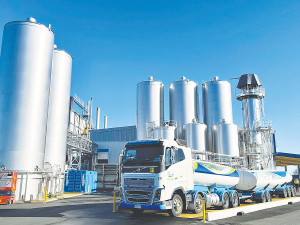Fonterra shaves 50c off forecast milk price
Fonterra has dropped its forecast milk price mid-point by 50c as a surge in global milk production is putting downward pressure on commodity prices.
 Fonterra has invested $40 million at its Tirau site to help concentrate whey permeate, making it more efficient to transport to its other sites to produce lactose.
Fonterra has invested $40 million at its Tirau site to help concentrate whey permeate, making it more efficient to transport to its other sites to produce lactose.
Fonterra is eyeing an increase in lactose production.
The co-operative has just invested $40 million in a move to help concentrate whey permeate at its Tirau site to make it more efficient to transport to other sites to produce lactose.
It’s a move the co-operative says is a positive step forward, creating better value return than the ethanol produced previously at the Tirau site.
During the dairy season’s peak, the plant produces up to 2 million litres of milk each day.
According to Fonterra general manager Central North Island Tony Maclean, 2.5 million litres of ethanol is also potentially stored there, meaning the plant is designated as a major hazard facility.
Maclean says that when the Tirau plant was built, there were benefits to converting lactose into ethanol.
“When the plant was built, the benefit of generating ethanol was primarily… set up reduce the amount of lactose that went to a wastewater treatment plant,” he told Dairy News.
Maclean says that at that time, harvesting the lactose as ethanol was seen as better than sending it on to wastewater treatment ponds.
He says that now, however, lactose produces more earnings for the cooperative than ethanol.
“Ethanol has limited usage. I mean, they made industrial grade ethanol there which was made for things like solvents and sanitisers where lactose can be used in a whole raft of pharmaceutical applications.
“The profitability from lactose as a product was greater than ethanol was.”
Maclean says the investment also means a lot for the co-operative in terms of its sustainability goals.
“We have a massive energy production per year,” Maclean told Dairy News, adding that energy production totalled 15,000 megajoules per year.
He says the move away from ethanol production towards lactose production will see reductions in CO2, water usage, wastewater and general waste. “So, it’s some pretty impressive numbers around those reductions.”
Maclean says there’s great value for money in the move as well.
“If you look at spending our shareholders’ money on remediating an asset to be compliant, around making that redundant and investing money into a brand new asset, with a slightly different product mix… the savings from that as well as the ability to generate lactose, we have the ability to reduce energy, reduce carbon, reduce water, reduce wastewater and waste,” he says.
Fonterra Edendale has been recognised with the Mars Dairy Supplier Quality Award for the top performing supplier sites in the global food company's dairy supply chain.
Sheep milk processor Maui Milk has achieved grass-fed certification of milk supply against the AsureQuality Grass-Fed Scheme.
OPINION: What goes up must come down. So, global dairy prices retreating from lofty heights in recent months wouldn’t come as a surprise to many farmers.
Fonterra directors and councillors are in for a pay rise next month.
Federated Farmers says it is cautiously welcoming signals from the Government that a major shake-up of local government is on its way.
Ashburton cropping and dairy farmer Matthew Paton has been elected to the board of rural services company, Ruralco.